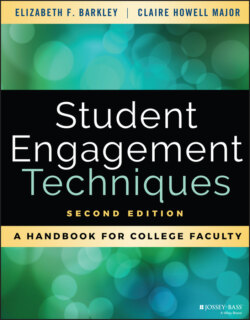Читать книгу Student Engagement Techniques - Elizabeth F. Barkley - Страница 63
Affect and Memory
ОглавлениеAt the center of the brain, sandwiched between the two temporal lobes, is the limbic region, an area that consists of a group of structures that regulate our emotions and our memory. Two of these—the hippocampus and the amygdala—perform essential roles in learning. The hippocampus plays a major role in consolidating learning and in controlling how memories are stored. Memories are not stored as a whole in one place; they are distributed throughout the brain in a dynamic, interactive system that the hippocampus helps retrieve and reassemble as necessary.
At the bottom of the hippocampus is a smaller structure called the amygdala. Since we are bombarded with perceptual stimuli every moment of our lives, our brain must determine what is most important so that we are not “on overload.” The amygdala is a vigilant monitor that reacts to experiences before we consciously understand them—especially to those that appear threatening or dangerous—by priming the brain to be alert for possible action. The amygdala performs this function by comparing incoming information with long-term memories from past experience, and then deciding what the body should do about it. The “fight or flight” response is an emotional response that happens before one's thinking brain, the cortex, can get involved because stopping to think would take too long before a needed decision was made (Newquist, 2004; Ratey, 2002; Wlodkowski, 2008).
When we are not in life-threatening situations, the hippocampus and the amygdala work together to help us “read” nonverbal information, interpret social situations, and understand and deal with our own and other's feelings. The upper cortex, which involves our thinking brain, and the lower limbic structures, which involve our emotions, are in continuous communication with each other. Interestingly, there are many more connections from the small emotional limbic center into the large logical and rational cortical centers than the reverse. When emotions overwhelm us (we become too scared or too excited) we can usually use the reasoning centers in our cortex to overrule and manage them so that we can stay in control of our behavior—but not always, causing us to react or speak before we think (Newquist, 2004; Ratey, 2002, p. 228; Wlodkowski, 2008).
